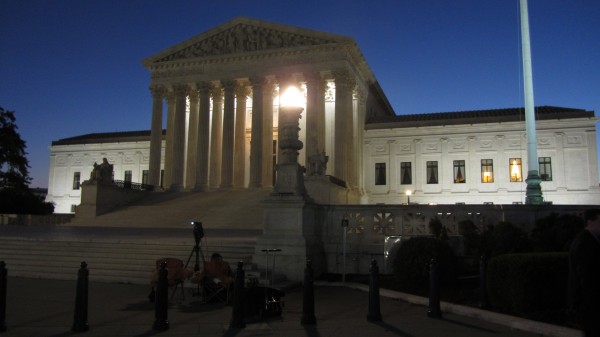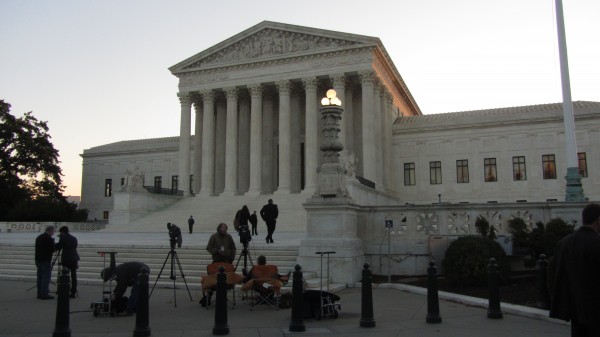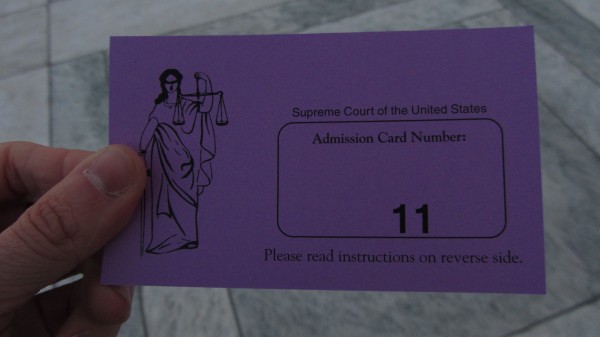It’s that time again: time to visit Washington, D.C. for more Supreme Court bobbleheads and oral arguments! I’m not going to try assembling the bobbleheads til I get home, so no pictures of them yet. Just (the first) oral argument for now.
Opening day!
Today’s argument was the first of the October 2014 term. This timing was of particular interest to me: I’ve been to arguments at other times of the year, but I figured opening day might be a little different. It was, although not significantly.
The public line outside included a few people who come every year to opening day arguments — with one person who’d been doing it for twenty-five years. (SCOTUS groupies! 😀 ) If I ever make it back for an opening day it’ll be interesting to see him again. Unlike past years I didn’t do much case-reading while waiting in line; too much interesting discussion and general camaraderie.
Inside the Court the difference was limited to Chief Justice Roberts announcing the close of the October 2013 session and the opening of the October 2014 session — essentially none, just another day at the office.
Now, a brief-ish recap of the case.
The facts of Heien v. North Carolina
One morning in 2009, two men, one of them Nicholas Heien, were driving through North Carolina. Sergeant Darisse noticed them as they passed by and found their behavior suspicious, so he started following them. Eventually Sergeant Darisse observed a reason to pull them over for violating a traffic law. (As a practical matter it’s impossible to drive for any length of time in perfect compliance with traffic law. But under Whren v. United States it’s perfectly acceptable to make “pretextual” stops, where the stop is really being made for some reason other than the immediate violation noticed.) The reason here was that Heien’s car had a malfunctioning stop lamp — that is, when the brakes were applied, only one stop lamp went on (and the other did not).
Sergeant Darisse and another officer asked the two men in the car a few questions, and they became more suspicious when the answers diverged. Sergeant Darisse asked if he could search the car. The driver said he’d have to ask Heien (as owner of the car); Heien said yes.
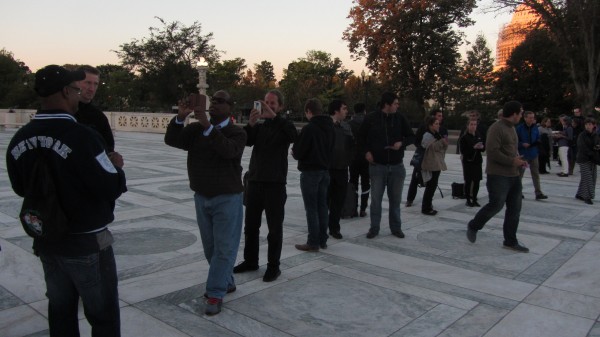
A brief interlude
Before we proceed further, I would like to emphasize something.
When an officer asks you if you consent to a search, you say NO.
If the officer is asking you, (at that moment) he needs your permission to do it. You do not have to grant permission. You will gain nothing if you grant consent. You’re not going to be on your way any faster; searching properly takes longer than not searching. And you never know what he might turn up. If it’s your vehicle, perhaps you had a passenger recently who left something in your car, that wouldn’t look good: drugs, drug paraphernalia, or a Justin Bieber CD. Practically, you can’t know what he’ll find. And even if you do: you’re not qualified to say what might be considered evidence of a crime, or even something that might be used against you in court for some other reason.
What if the cop promises it might get you moving faster, or tries to suggest you have nothing to hide, or whatever? Don’t believe him. Cops can legally lie to you. His verbal promise is worth the paper it’s printed on. Don’t talk to cops. My understanding is consent can’t be coerced or tricked. But good luck arguing you were tricked into it, given weasel words like “might” and it usually being your word against theirs.
Back to the facts: the result of the search
Of course (because otherwise we wouldn’t be hearing this case), the search found drugs. So now a traffic stop’s turned into a charge for trafficking cocaine. See what consenting to a search does? (Why would Heien have consented to a search, despite presumably knowing there were drugs in the car? Probably because he was legally intimidated or guilted into it. Again: Do Not Consent To Searches.)
In lower North Carolina courts
Heien challenged the stop on a number of grounds, only one relevant here: that the initial reason for the stop wasn’t valid. North Carolina law requires a working “stop lamp” (singular; emphasis added). Heien’s car had a working stop lamp. If the law is properly read that way, there was no valid reason for the initial seizure, and so by fruit of the poisonous tree the result of the search here can’t be admitted in court. (Glossing over a few details, but I’ll circle back to them.)
The trial court disagreed with Heien, but on appeal a North Carolina court of appeals agreed. The law required only one working stop lamp. And a law requiring vehicles “shall have all originally equipped rear lamps or the equivalent in good working order” didn’t apply, because stop lamps were not “rear lamps”. (“Surprising”, as the dissenters at the North Carolina Supreme Court later noted — but also fairly justified by careful reading of the statutory text.)
The court of appeals then concluded that Heien’s seizure was not permissible under the Fourth Amendment, which prohibits “unreasonable” seizures — and a seizure based on a misunderstanding of law is inherently not reasonable.
At the North Carolina Supreme Court
North Carolina didn’t contest the validity of the traffic law interpretation. Until North Carolina rewrites its laws (which, to be fair, weren’t originally buggy — back in the day only a single stop light wasn’t unusual, it’s just the law hasn’t been updated since 1955), at least in some parts of North Carolina you can legally drive with a broken stop lamp, if you have another that works. Instead North Carolina argued that the stop was a “reasonable” Fourth Amendment seizure: the officer made an “objectively reasonable” mistake of law, that had a “foothold” in the text (whatever that precisely means), which should be enough for the seizure to be reasonable.
Another interlude: good faith
Now an interesting quirk arises. Per United States v. Leon and subsequent precedents, the exclusionary rule that prevents admitting evidence obtained through a Fourth Amendment violation is riddled with holescontains a good faith exception for various cases where a violation occurs, but it’s deemed society’s interest in not ignoring the usually-obvious truth trumps the exclusionary rule’s benefits to individuals. So for Heien to get off, he has to argue that the Fourth Amendment was violated and that he’s entitled to the remedy of suppression and that no good faith exception applies.
Except that’s not the rule in North Carolina. North Carolina’s Supreme Court has interpreted some combination of the Fourth Amendment and its own constitution (I’m not 100% sure on the details) to contain no good faith exception. If the police violate the Fourth Amendment and you’re prosecuted under North Carolina law, evidence from that violation must be suppressed. (But see two paragraphs down.)
So Heien’s job is much easier. He needs a Fourth Amendment violation, but he doesn’t also need courts to feel “sorry enough” for him to suppress the evidence: North Carolina’s already done it for him.
Back to the North Carolina Supreme Court
North Carolina’s argument that the seizure, as an “objectively reasonable” mistake of law, was a valid Fourth Amendment seizure succeeded at the North Carolina Supreme Court by a 4-3 vote. (North Carolina’s not the first court to consider this question. Nine circuit courts have considered this question. Only one has adopted the North Carolina Supreme Court’s position.) Note carefully how the North Carolina Supreme Court in effect created an alternative version of the good faith exception, just without calling it one. (The dissenters specifically called them on this.) There’s increasing pushback in North Carolina against the lack of exception, culminating in 2011 in a statutory good faith exception and a legislative call for their court to reconsider the constitutional lack of such an exception. (I don’t know the extent to which that statute and the constitutional interpretation cause conflicts North Carolina courts will have to sort out. In any event the statutory exemption can’t apply retroactively to Heien.)
At the United States Supreme Court
The (United States) Supreme Court agreed to take the case to decide whether a cop misunderstanding the law, is enough to justify a search. It didn’t decide to take on the applicability of a good faith exception to such a mistake: only whether it was a Fourth Amendment violation.
Legal analysis
Both sides here actually have pretty good arguments from precedent for their positions. The Court has previously held that cops don’t have to predict that a law might later be held unconstitutional: they can enforce laws as they’re written, without worrying whether the laws are valid or not (“with the possible exception of a law so grossly and flagrantly unconstitutional that any person of reasonable prudence would be bound to see its flaws”). That case has various logic in it that cuts strongly in favor of North Carolina, but also a few parts that arguably exclude mistakes of law from consideration. Another, more recent case, Ornelas v. United States cuts the other way. And various other cases lend support to each side.
There’s enough evidence in case law to support each side that it’s hard for me to fault a judge for coming down on either side here, on the basis of case law. I think that says something about the case law, to be honest.
Rather, what seems stronger to me ultimately is the common law presumption that “ignorance of the law is no excuse”. If you violate the law, you’re still guilty even if you didn’t know the law. Heien beats on this point pretty hard: that it’s unfair to punish someone for a law he didn’t know about, but it’s okay for a cop to stop someone for an offense that doesn’t actually exist because of what, ultimately, is ignorance of the law. North Carolina and the United States try to distinguish this by saying that a cop who breaks a law he doesn’t know about is held to it as much as a normal person. But this on-the-job, off-the-job wax-on, wax-off argument is way too cute for me.
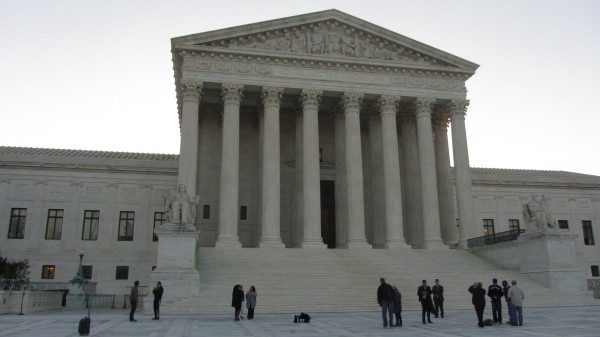
Oral argument
Going into oral argument I didn’t have much sense how things might turn out. The common law rule seemed like it might speak to some at the Court. But the shining ideal of the exclusionary rule we’re all familiar with, has been steadily chipped away at for several decades. That chipping continues with the current Court. That general trend didn’t bode well for Heien.
I counted a few votes that looked fairly likely for Heien — Sotomayor pretty strongly, Ginsburg and Kagan to lesser extents. Roberts pushed about equally hard on each side in questioning. The rest seemed somewhat more in opposition to Heien than to North Carolina. Heien’s side got more pushback in oral argument than either North Carolina or the United States, all things considered. But the most striking part of argument was how it took multiple turns for the bizarre.
Justice Scalia asked why Heien wasn’t pushing for mistake of law triggering no good faith exception, in addition to it being a Fourth Amendment violation. This despite the presence of North Carolina’s non-recognition making the point irrelevant. He seemed to think the two questions were inseparable and had to be answered together. Which is a fair question — when deciding whether to review the case. But the Court took the case to answer only the one question, whether there was a Fourth Amendment violation, leaving the question of the remedy for such violation to another day. And the Court can’t really decide the question of remedy here, because it’s irrelevant to Heien and thus is not a “case or controversy” that the Court is empowered to decide here. I claim no knowledge of precedents, but it seems really unlikely to me (and Heien’s counsel had ready examples) that the Court hasn’t half-decided an issue like this before.
Meanwhile, Justice Alito wondered why North Carolina could get away without having a good faith exception: why weren’t they held to the federal rule? Which is an interesting question. But first, that question wasn’t accepted for argument, or argued below. And second, I thought Pruneyard Shopping Center v. Robins allowed states to interpret their constitutions (as North Carolina has done) to more strongly protect rights than federal courts would. (We might suppose from this that Justice Alito is rather a fan of the good faith exception [he said, understatedly, because Justice Alito is generally known to defend the police much more often than not].)
Finally, a few justices (Ginsburg, Alito, Kennedy) asked questions along the lines of, “If there was consent to search, given after the traffic stop had ended as a Fourth Amendment seizure, doesn’t that make the evidence admissible?” To which the clear answer, fruit of the poisonous tree (there is no chance to ask for consent to search, if there is no mistake-of-law stop), seemed so obvious to me as a decently-read non-lawyer (and to a couple other knowledgeable lawyers I talked to after argument), that clearly those justices were missing something really obvious. Or that law is less settled than I thought. (Which is entirely possible. But see the lawyers’ reactions.) But in any case it wasn’t the question presented, and wasn’t an argument North Carolina made in lower courts.
Predictions
Given the thoroughly strange turns in argument, I’m really unsure what’ll happen. The Court could dismiss the case as “improvidently granted”, because it’s not worth answering the Fourth Amendment question without also answering whether a good faith exception also applies, and they flat-out screwed up accepting the case. In which case, everyone wasted their time. 🙂 The Court could answer the original question as saying there is a Fourth Amendment violation, then “somehow” also manage to answer the good faith question that was never seriously argued before — despite it not being relevant because of North Carolina jurisprudence. Or they could vote for North Carolina. But there was enough random confusion that it’s hard to guess much about who might win.
So in the end…yeah, I dunno. I don’t see any reason why the Court can’t decide for Heien or for North Carolina, and maybe in conference the justices can collectively learn enough to see why that’s so. Some of them clearly weren’t there yet, at the start of the day. Where they go from there, also unclear. I’m guessing the odds are still against Heien, but I could easily be wrong.
Other random observations
I arrived in line early enough (about 05:20) to receive card #11, solidly within the first fifty people in the public line to get a seat. (I think there were only actually eight people in front of me, and a few numbers got skipped.) This was a much better showing than the last Fourth Amendment case I attended, where I arrived at something like 02:00 and wasn’t joined by anyone else til 06:15. Just ahead of me was the man who’s attended the last twenty-five opening days, and a couple friends of his.
In front of them was a rather unusual delegation: several people from the North Carolina police department that had seized Heien, including Sergeant Darisse himself! (North Carolina apparently only received six seats at oral argument, which presumably all went to the attorney general’s office. That’s surprisingly stingier than I’d have expected.) I imagine watching a case from that vantage point would be…kind of mind-boggling, actually. I asked about a picture, but occasional undercover work precluded it. 🙁 No idea whether Heien himself was at the Court — apparently he finished serving his sentence, or at least is out now, so he might have been there. Of course, as actual party (as opposed to merely the agent of a party) he presumably would have no trouble attending.
In other associated mild celebrity meetings, I got to meet Orin Kerr of the Volokh Conspiracy, and very briefly (I didn’t introduce myself, just was present as he and Orin briefly talked after leaving the Court) Jeffrey Fisher of Stanford, most recently known for having successfully argued Riley v. California, the cell phone search case from last term.
Conclusion
In the end it seems almost commonsense to me that when you’re breaking no law, and there’s no confusion that you might possibly have been breaking the law in its actual meaning, you should be safe against searches and seizures. (Note that a mistaken understanding of facts, in contrast to a mistaken understanding of the law, doesn’t invalidate a search or seizure. For example, suppose someone liked having “fun” playing a recording of a woman’s screams in his back yard. It should be totally justified for a cop to investigate that, even if the facts are that no domestic violence or other crime is being committed.) Ignorance of the law should apply equally to everyone, and not differently to a cop acting to enforce what turns out not to be the law.
But it’s a long line of cases that have lent support to the notion that searches and seizures not consistent with the law, as ultimately interpreted by the courts, can still produce fruits for investigations and prosecutions. And so eventually we reach the point where someone can be detained for not violating the law identified as the reason for the seizure, and it’s a legitimate question whether the seizure is reasonable or not.
I don’t agree with the retired Justice Stevens on a number of issues. But in this case, judging by his dissent in United States v. Leon, I wish he were still voting on the Court.
(And, as always — and particularly here, because Fourth Amendment law is very clearly not a thing quickly or easily understood, and I am still only scratching the surface in my knowledge of it — please point out any mistakes I’ve made in my discussion here. 🙂 )
